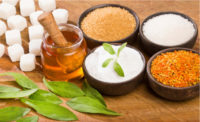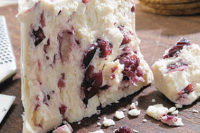The report says that high-intensity sweeteners will remain the largest product category among alternative sweeteners, with newer alternative sweeteners experiencing the fastest growth. In particular, expect to see more dairy products and beverages formulated with stevia-based sweeteners, as well as monk fruit. According to the report, both are on trend with a natural positioning that consumers are increasingly seeking out on product labels. Also, full-calorie agave nectar is gaining traction due to its natural positioning as an alternative to high-fructose corn syrup in terms of both sweetening power and functionality.
Formulators are learning that blending alternative sweeteners, sometimes with the help of a little sugar, is the most effective way to develop a product that resembles the sugar-only sweetened version, but with fewer calories. For example, sucralose is compatible with most nutritive sweeteners and can be used to replace up to 30% of sugar in many formulations with no detectable difference in taste.
Another alternative sweetener that blends well with nutritive sweeteners is neotame. Research indicates that in some applications, it is possible to replace 25% of a nutritive or high-intensity sweetener with neotame without any formulation adjustments while maintaining a product with similar sensory attributes.
But the buzz in the sweetening world is on two plant extracts that have super sweetening powers, yet, unlike other high-intensity sweeteners, are not categorized by the FDA as artificial. Thus, the natural products industry is embracing these sweeteners because zero-calorie sweetness had not been available to the natural products consumer.
Stevia-based sweeteners are the more widely known of the two. Based on extracts (primarily the steviol glycoside known as rebaudioside A, or simply reb-A) from leaves of the Stevia rebaudina plant, stevia-based sweeteners are 200 to 300 times sweeter than sugar. With reb-A being one of more than 10 sweet-tasting compounds in the stevia plant, suppliers are differentiating themselves by reb-A content.
The other is monk fruit, also known as luo han guo (Siraitia grosvenorii). This small, vine-grown, subtropical fruit gets its zero-calorie sweetness from naturally occurring antioxidants called mogrosides, which are up to 300 times sweeter than sugar.
The polyol erythritol also has made inroads in the all-natural dairy products business. What makes erythritol different than most other alternative sweeteners is that it has only about 60% of the sweetness of sucrose, yet maintains a similar bulk density. These attributes make it an attractive partner to other high-intensity sweeteners, in particular stevia-based sweeteners, as the combination generally provides a sweetness profile and mouthfeel comparable to sucrose only. Erythritol is also said to help mask the off flavors and lingering aftertastes associated with some stevia-based sweeteners.
Every sweetener has unique properties. These include sweetness intensity, bulk solids contribution, flavor and color notes, and even impact on blood sugar. Finding the right combination can set your product apart from others in the crowded marketplace.



